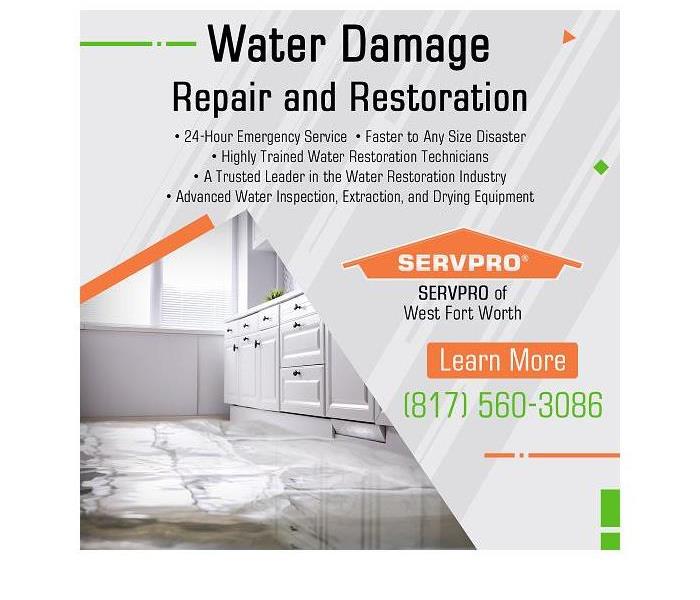The Difference Between Extraction and Mitigation Techniques in Water Damage Restoration
3/16/2021 (Permalink)
Blog Summary: The experts at SERVPRO explain the difference between water extraction and water mitigation, including when each method is necessary and the benefits of proper water damage restoration.
There are many steps in the water damage restoration process, but arguably the most important is water extraction and mitigation. What is the difference between the two, and what role do they play in the water damage restoration process?
The specialists at SERVPRO of West Fort Worth, TX, utilize a comprehensive five-step approach to water damage restoration, including both extraction and mitigation. Here is what they had to say about the difference between these two vital water restoration techniques.
Water Damage Restoration: The Difference Between Extraction and Mitigation
#1: Extraction is the first step.
Water extraction is the first step in the water damage restoration process. First, the technician will identify the water source and take steps to prevent further damage if possible, such as turning off the water main or covering broken windows or roof damage.
Then, they can begin extracting, or removing, the bulk of the water from the space. Even if there isn’t standing water, extraction is still necessary to remove water from absorbent surfaces, such as carpeting.
Only after extraction is complete can mitigation efforts begin. During the mitigation process, humidity levels are brought back to a safe level, and building materials are thoroughly dried.
#2: Water extraction and mitigation have different purposes.
While both water extraction and water mitigation have a similar goal, they do so on different levels using different tools. Water extraction focuses on removing the majority of the water, while mitigation focuses on reducing any remaining moisture.
Bulk water removal will help prevent additional structural damage. For instance, drywall will absorb water at a rate of about one inch per hour. The faster standing water is removed, the better. On the other hand, reducing moisture helps bring humidity levels down and prevent the growth of mold.
Mold begins to reproduce in high humidity areas in less than 24 hours, can damage building materials, and can pose health effects.
#3: Each process uses different machines and techniques
Water extraction typically includes two primary tools:
- Submersible Pumps: In cases of standing water, submersible pumps may be necessary. These gas-powered industrial pumps can pull thousands of gallons of water from a space per hour, feeding it either to a storm drain or transport vehicle.
- Industrial Wet/Dry Vacuums: For less extensive flooding or after the pumping process, wet vacuums are effective for removing excess water and moisture from flooring and other surfaces. In cases, these systems also pump a cleaning solution to remove moisture and contaminants at the same time.
Water mitigation involves equipment such as:
- Industrial Dehumidifiers: These machines work just like a small household dehumidifier but on a much larger scale. Many units can pull more than a gallon of water from the air per hour.
- High-Speed Fans: Fans help to evaporate left-over moisture and restore correct humidity levels in the property.
- Moisture Detectors and Monitoring Equipment: Specialists use a wide range of advanced tools to locate hidden moisture and continuously monitor the moisture levels of floors and walls throughout the restoration process.
About SERVPRO of West Fort Worth
Efficient water extraction and mitigation are both necessary to have a successful restoration after water damage. Serving Azle, Fort Worth, and surrounding areas, SERVPRO of West Fort Worth has more than 50 years of experience in the water damage restoration industry. Their professionals can handle everything from water removal to mold remediation.
For more information about water damage restoration in Azle, TX, contact SERVPRO at (817) 560-3086 or visit them on Facebook.
Contact Information:
SERVPRO of West Fort Worth
8008 Camp Bowie W Blvd
Ste #106
Fort Worth, TX 76116
www.SERVPROwestfortworth.com/






 24/7 Emergency Service
24/7 Emergency Service
